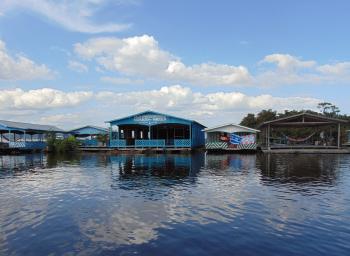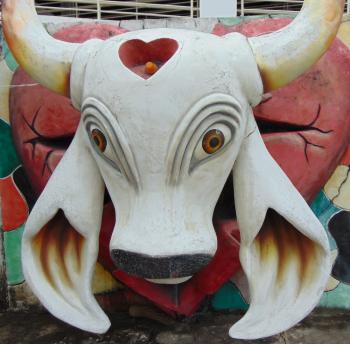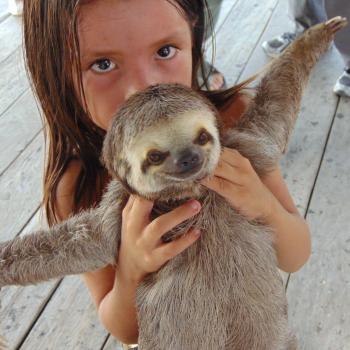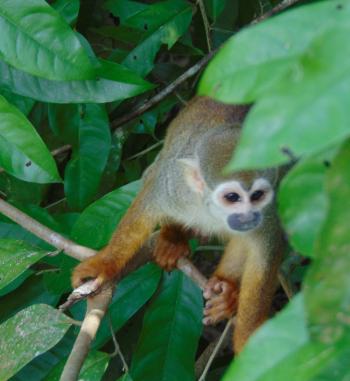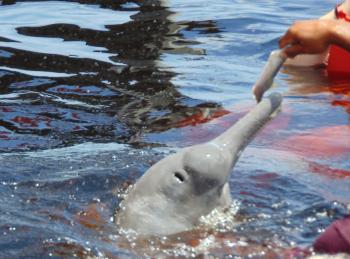Cruising the mighty Amazon
This article appears on page 32 of the September 2017 issue.
We decided South America would be our travel destination this year, so we booked a 22-day “Amazon Exploration” cruise on board the Regatta, a 684-passenger ship operated by Oceania Cruises (Miami, FL; 855/335-2728, oceaniacruises.com). The ship left Miami on Feb. 2, 2017, sailing first through the Caribbean and finally reaching the mouth of the Amazon River on the night of Feb. 10.
The cruise fare for the two of us was $15,744, which included balcony-cabin accommodations, round-trip airfare from Charleston, South Carolina, unlimited Internet, five shore excursions of our choice, a beverage package and a $1,000 ship credit.
On the river
We knew that the Amazon, or Rio Amazonas, is the largest river (by volume) in the world, but we were still unprepared for its immenseness. The average discharge of water from the Amazon River is greater than the amount discharged from the world’s next six largest rivers combined!
Upon entering the mouth of the Amazon, we picked up very strong river currents, which challenged our ship and resulted in very slow cruising days.
We were sailing during the rainy season (December through April), and the river was beginning to expand beyond its normal shorelines. During the next several months, it would expand by more than a mile in width, creating flood conditions all along its banks.
First stop: Parintins
We had a quiet sailing to our first port stop in Parintins, Brazil, known for its Boi Bumbá Folk Festival. The festival is held annually in June and is second in size and popularity only to Rio de Janeiro’s Carnival.
The festival, based upon a local legend about a resurrected bull, is the center of competition between two teams: the Garantidos and the Caprichosos. Each team portrays the story of the resurrected bull through colorful and elaborate parades, floats, songs and dances throughout the 3-day festival period.
The local guide for our city tour explained the rivalry between the city’s two teams, which could be clearly seen in the city’s neighborhoods, where the houses are painted either red or blue. In fact, everything in the city is either red or blue, except the city’s tallest structure, Catedral Nossa Senhora do Carmo, the Roman Catholic cathedral.
We visited the huge Sambódromo arena, the central hub of festival activities. The arena’s exterior walls are covered with very impressive murals depicting the history and culture of the city and its festival.
After returning to the ship for lunch, we walked back into town for a performance of the Boi Bumba Folk Show. This show is derived from the same folk legend on which the festival is based. Luckily, our guide from the morning tour had given us enough of the story line that we had a greater appreciation of the symbolism of the show, but it wouldn’t have mattered, as this was a fantastic show, including music, dance, drumming and elaborate costumes. Many of us still felt the beat of the music as we made our way back to the ship.
Manaus
After traveling 260 miles up the Amazon, we reached the city of Manaus, on the Rio Negro, where we spent two days. What is a city of two million people, whose access to the rest of the world is only by boat or plane, doing in the middle of the jungle? Rubber is the reason! In the 19th century, Manaus helped supply most of the world with natural rubber before the development of synthetic rubber and an expansion in Asian rubber production greatly reduced the demand.
Through Cruise Critic Roll Call — an online forum (at www.cruisecritic.com) that allows passengers booked on the same cruise to “meet” before the cruise and plan for shared private port tours — 16 passengers from the Regatta organized two days of touring with Rodolpho Emanuel of Amazon Destinations Tour Company (phone +5592 4101 1800, www.amazondestinations.net).
The first day’s tour was a “Full Day River Tour” ($100 per person). Our transportation for the entire day was a very comfortable speedboat with an overhead covering, life jackets, lunch and a cooler filled with beer and mineral water.
Before leaving on this cruise, our family was afraid we would be going up and down the Amazon tributaries in a less-than-desirable boat, so we quickly took a picture of the boat to reassure those back home that this was a very clean, well-maintained boat with a delightful young couple as the captain and “first mate.” The boat’s capacity was 50, so we had more than enough room for the 20 passengers and crew.
Rodolpho met us at the gangplank in Manaus and immediately asked if we had brought our bathing suits and towels, as our first activity would be to swim with the famous pink Amazon river dolphins.
On the 30-mile ride up the Rio Negro, which joins the Amazon just east of the city, Rodolpho explained the history and culture of the area.
Upon reaching our destination, we tied up at a floating dock and Rodolpho briefly explained that the pink Amazon dolphins are considered to be the most intelligent of the dolphin species. These friendly mammals have lived amicably with human beings for centuries and have survived because, according to ancient legend, harming a dolphin brings bad luck. (Unfortunately, their numbers are now threatened by fishing and by pollution from agriculture, industry and mining.)
Most of our group entered the water, where they were soon surrounded by flocking dolphins swimming back and forth and surfacing for the treats that the staff provided.
After a while we said good-bye to the dolphins and climbed back aboard our boat ready for the next adventure, a visit to the indigenous Tatuyo tribe. We were greeted at the dock and escorted up to a hut, where the men and women of the tribe performed several traditional dances, asking us to join them at the end.
Following the performance, they invited us to have a snack of fried ants (they were rather crispy), fish cooked on a wood fire and a flat bread that, Rodolpho explained, was made from cassava root. (You might know it as yucca or manioc.)
One of the ladies in our group said that when manioc is dried, it is called tapioca. Ah ha! So that is why the bread was rubbery and rather bland tasting!
Assured that the “snack” at the village was not our lunch, we headed downstream to a floating restaurant, where we had a surprisingly good buffet lunch consisting of a variety of fresh tropical fruits, fried plantains and pirarucu, a local fish, served grilled, fried or in a stew.
There were several vegetables we did not recognize, including one that looked like thick French fries. Rodolpho explained that it was cassava, which we had just tasted in the flat bread. Prepared this way, however, it was quite good!
Unusual sights
Once our bellies were full, Rodolpho announced, “Now is the time for insect repellent! Let’s go on a hike back into the rainforest to see the large lily pads.”
Along the way, Rodolpho pointed out the various flora and fauna. This area is known for the endangered small monkeys called pied tamarin, and we saw a lot of them. They were having a grand time scampering along the path with us.
The trail ended at a lake covered with the largest lily pads we had ever seen. While none of the lilies were in full bloom, the buds were pretty — about the size of a very large grapefruit.
Rodolpho pointed out a wattled jacana, a pretty, chestnut-brown-and-black bird, walking along on the huge lily pads just like they were stepping stones. A very impressive sight, indeed!
We returned to the boat and headed back toward Manaus. En route, the boat’s skipper detoured to show us a fairly large floating community complete with a church, school, bar and meeting house and floating gardens that looked like they were growing everything from salad greens to lime trees.
We ended this beautiful day at the Meeting of the Waters, a natural phenomenon caused by the dark, almost blue-black Rio Negro meeting the muddy brown water of the Amazon (known here as Rio Solimões). The two rivers run parallel without mixing for approximately 6 kilometers. We were told that this occurs because of the rivers’ differences in temperature, composition and speed.
We had read about this phenomenon, but to actually see it was amazing.
To market
Our second day’s tour was a 5-hour “City Tour of Manaus” ($40 per person). Rodolpho picked us up at the gangway of the ship and we boarded a beautiful, very large touring bus. There were a great deal of clouds in the sky, so, being afraid it might rain, he immediately took us to Mercado Municipal, the local market designed to resemble Les Halles market in Paris. It is a dramatic cast-iron building with striking stained-glass windows.
Most of the vendor stalls sold items geared to tourists. Venturing down to the far end, we found a wonderfully clean meat market; all the meat was cased in refrigerated glass cases. What a difference from other meat markets we have visited on our travels!
Some of the market stalls had unusual herbs and potions. Rodolpho explained that locals were very superstitious and used a lot of herbs and potions to appease or ward off spirits.
Then we headed to the fish market, housed in a huge, well-lit building. But, golly, you had to watch your footing, as the floors were wet and slippery, and you needed to keep your eyes alert all the time, as men were walking around carrying huge fish on their shoulders.
Rodolpho took us to a couple of fish stands and explained the different varieties of fish, pointing out the pirarucu fish that we had for lunch the previous day. We were amazed at the sizes and variety of catfish.
From the fish market, we walked through the produce market, a huge warehouse filled with bananas and plantains.
As it started to rain, we boarded the bus for a sightseeing drive around the city, with Rodolpho providing background history. We visited the Palácio Rio Negro Manaus, a palace built as a gift for the wife of a German rubber baron.
From the palace, we went to Teatro Amazonas. Like so many of the buildings in Manaus, this ornate opera house was constructed during the height of the rubber boom. We ended the day with a tour of the more affluent sections of Manaus and the beach resort area.
Rodolpho is an excellent guide and one we would highly recommend. He is extremely organized and has incredible attention to detail, making everyone feel very comfortable.
A private tour
After departing Manaus, our ship made a short stop at the small village of Boca da Valeria. We anchored out in the Amazon at the entrance to the Valeria River and tendered in to a small dock. This tiny settlement has about 10 huts/houses built on stilts, a small one-room schoolhouse, a community meeting place (known as a bar) and a small church.
Word went out quickly that a ship had arrived, and small boats and dugout canoes appeared from all directions, the locals descending on the area to offer their handicrafts for sale. The ship’s crew gathered gifts and day-to-day living items to be taken ashore and distributed to the residents of this small community.
Our final port of call on the Amazon was Santarem. Through Cruise Critic Roll Call, we learned about a tour guide there and made arrangements for a full-day river tour with Gil Serique (phone +55 93 99115 8111, www.facebook.com/gil.serique) for $130 per person, payable on arrival.
When we got off the ship to meet Gil, it was raining. Never travel in the Amazon without rain gear! Properly dressed for the occasion, we headed out for a day of boating on the Tapajos River. The boat was old and looked like many we had seen cruising up and down the Amazon, resembling a modified fishing/house boat.
Gil is a naturalist and an environmentalist, and once we got into the river channels he provided information on the ecology of the river and its surrounding vegetation and on the cultures of the villages.
To help identify birds and animals, Gil passed out a small pamphlet he had written, “The Essential Wildlife.” The pamphlet proved to be an immense help, as it was filled with pictures of the birds and animals we might be seeing.
The rain stopped, the blue tarps were removed from the sides of the main-floor deck, and we were able to go up onto the large open-air area at the front of the boat. We smelled wonderful aromas and soon realized that we were standing on the roof of the very small kitchen below, where the wife of the skipper was busy fixing our lunch.
Gil and his assistant, Alex, a German with a BS in biology and an MA in ornithology, stationed themselves on the upper deck, spotting the birds in Gil’s book. We saw a lot of them, including Amazon kingfishers, egrets, limpkins, wattled jacanas, lesser yellow-headed vultures, yellow-billed terns, black skimmers and a savanna hawk. Some saw a toco toucan and several parrots, but most of us were never fast enough to see them.
It was delightful to see 3-toed sloths lounging in their natural habitat, and we heard howler monkeys and saw a group of squirrel monkeys.
We ended our visit to the Amazon with the traditional ceremony hosted by King Neptune, gatekeeper of the equator and Ruler of the Seven Seas, initiating all the novice Pollywogs (those crossing the equator for the first time) into the secret society of Shellbacks — truly a befitting ceremony as we crossed the equator and concluded our journey on the mighty Amazon.

